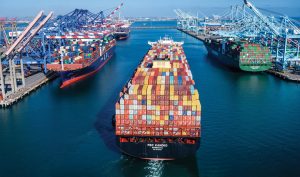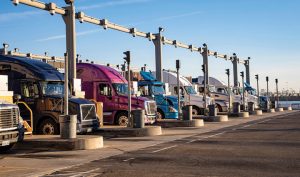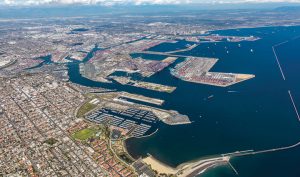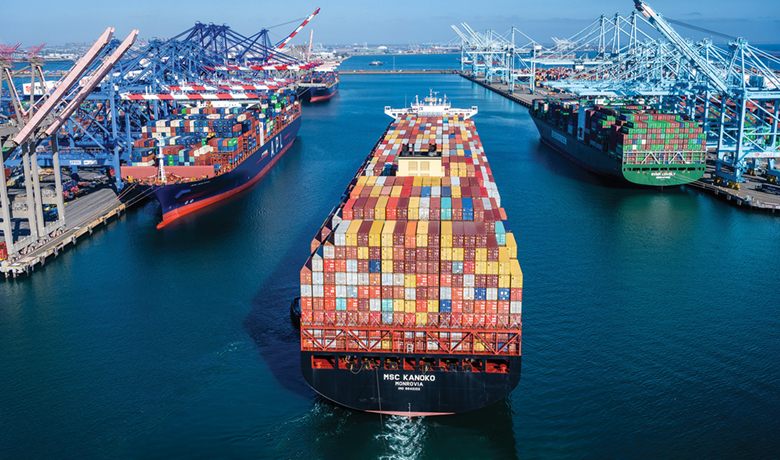
Industrial giants are often the first to be called upon when the nation demands environmental change.
West Coast shipping terminals occupy prime waterfront real estate—each of them operating right on the doorstep of a major metropolis. In the regular course of business, they utilize waterways alongside sensitive marine populations and ecosystems already stressed by human activity.
Over the last few decades these ports have made major strides in the move toward greening their operations and being accountable for their impacts on their local environments while servicing goliath cargo ships.
The California ports of Los Angeles and Long Beach share San Pedro Bay and, ultimately, their impacts.
“We’re joined at the hip when it comes to environmental projects,” said Lee Peterson, media relations manager at the Port of Long Beach. “We want to be part of the solution—we’re not just sitting back on this. We want to do better.”

Diesel-to-Electric Conversion
One of their main projects is to try to reduce greenhouse gases from the trucks that serve the ports by converting from diesel fuel to electric power.
Not an easy task, considering Los Angeles is America’s leading seaport by container volume and cargo value.
“We are excited to be installing one of the first heavy duty public charging stations here at the Port of Long Beach,” said Matt Arms, director of environmental planning for the port, “and have just released a request for information to gain a better understanding of the design concepts, business models, operational plans, barriers and high-level costs associated with publicly accessible electric-charging infrastructure here …”
Partnerships to Combat Air Pollution
In another recent development, the Port of Long Beach has entered into a partnership with the Port of Los Angeles, the Port of Shanghai and C40 cities to create the first-of-its-kind green-shipping corridor. This is monumental, as the trans-Pacific connection is the busiest container shipping lane globally.

“The purpose is to reduce emissions in the open ocean,” said Chris Cannon, chief sustainability officer for the Port of Los Angeles.
In a press release, C40, a global network of mayors taking action to confront the climate crisis, stated that the partnership’s goal will be to develop a “Green Shipping Corridor Implementation Plan” to phase in trans-Pacific container ships, with low-to no emissions. The goal is to reduce supply-chain emissions from port operations to improve air quality. The plan will provide an outline for how to continue to decarbonize this key maritime shipping corridor.
The Port of Shanghai, located on the China coast at the mouth of the Yangtze River Delta, is the world’s largest port.
Beneath the Waves
Reducing air pollution is not the only aspect of green stewardship currently being addressed. The Washington State ports of Seattle and Tacoma must consider the conditions of the area’s waterways, along with the salmon population and resident orca pods that live in Puget Sound. What’s underneath the water is of the utmost importance.
“Our environmental team was instrumental in setting up the Quiet Sound program, which will reduce underwater noise from large commercial vessels,” said Jon Sloan, the Port of Seattle’s senior manager for maritime environment and sustainability.
Underwater noise affects the resident orcas’ ability to hunt, communicate and avoid danger.
“Through Quiet Sound, we’re proud to be part of an industry-led solution that will help this iconic species thrive once again in Puget Sound,” Sloan said.
The program sets out to improve the reporting of whale sightings and the ability to get that information to the pilots of large vessels in the Salish Sea so they can slow down or move away from the orcas.
The Port of Tacoma reports that it also has partnered with the Port of Seattle and the Northwest Seaport Alliance (NWSA), along with other agencies, tribes and organizations, to require cargo ships to practice what is called “slow steaming”—or deliberately reducing the vessel’s cruising speed when entering the waterway. This is designed to prevent accidents with marine mammals including seals, sea lions and orcas.
Protecting Waterways
Sloan said the port created an Ocean Acidification Action Plan last year that lays out steps to address the problem through cost-effective local actions.
Seattle is the first port in the world to join the International Alliance to Combat Ocean Acidification.
“The port’s multi-site mitigation bank will generate freshwater, estuarine and saltwater mitigation credits that can be used by the port to offset future development impacts or sold to others to generate revenue for our habitat restoration program,” he said. “Habitat projects being undertaken in the bank are important for salmon recovery, flood protection, water quality and many other natural resource functions.”
Community Involvement
The Port of Seattle has long been a leader in maritime environmental action said Alex Adams, its senior manager for environmental programs.
“Through a partnered approach with other ports, industry, governments, communities and tribes, we’ve made significant strides forward in efforts to equitably address climate change, reduce air emissions and ensure that Puget Sound’s water quality and near-shore habitats are restored and preserved for future generations.”

